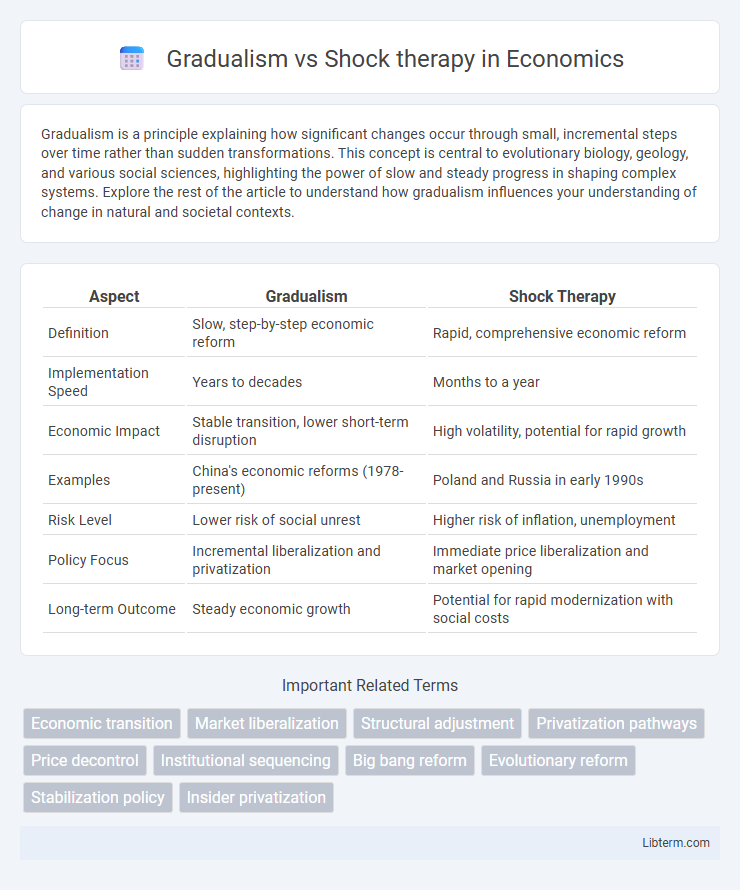Gradualism is a principle explaining how significant changes occur through small, incremental steps over time rather than sudden transformations. This concept is central to evolutionary biology, geology, and various social sciences, highlighting the power of slow and steady progress in shaping complex systems. Explore the rest of the article to understand how gradualism influences your understanding of change in natural and societal contexts.
Table of Comparison
| Aspect | Gradualism | Shock Therapy |
|---|---|---|
| Definition | Slow, step-by-step economic reform | Rapid, comprehensive economic reform |
| Implementation Speed | Years to decades | Months to a year |
| Economic Impact | Stable transition, lower short-term disruption | High volatility, potential for rapid growth |
| Examples | China's economic reforms (1978-present) | Poland and Russia in early 1990s |
| Risk Level | Lower risk of social unrest | Higher risk of inflation, unemployment |
| Policy Focus | Incremental liberalization and privatization | Immediate price liberalization and market opening |
| Long-term Outcome | Steady economic growth | Potential for rapid modernization with social costs |
Understanding Economic Transition Strategies
Gradualism emphasizes a step-by-step approach to economic transition, allowing markets, institutions, and policies to adapt progressively over time, which helps minimize social disruption and economic instability. Shock therapy advocates rapid liberalization, privatization, and stabilization reforms to quickly dismantle old economic structures and promote market efficiency, often leading to initial sharp contractions but faster recovery. Understanding these strategies involves analyzing their impacts on inflation control, unemployment rates, foreign investment inflows, and overall GDP growth during transition periods.
Defining Gradualism in Economic Reform
Gradualism in economic reform emphasizes a step-by-step approach to transition markets, allowing institutions and policies to adapt incrementally and reduce social disruption. This method prioritizes stabilizing inflation, building legal frameworks, and encouraging private sector growth through phased deregulation and privatization. Gradual reform often results in more sustainable economic development by promoting investor confidence and minimizing economic shocks compared to abrupt transformations.
Explaining the Concept of Shock Therapy
Shock therapy refers to a rapid and comprehensive approach to economic reform that aims to transition a country from a controlled to a market economy by implementing sudden price liberalization, privatization, and stabilization policies. This method seeks to quickly eliminate distortions, reduce hyperinflation, and attract foreign investment, but can cause short-term social and economic disruption due to the abrupt changes. Prominent examples include Poland and Russia during the early 1990s post-communist transition.
Key Differences Between Gradualism and Shock Therapy
Gradualism focuses on implementing economic reforms step-by-step, allowing markets and institutions to adjust slowly, while shock therapy advocates for rapid, large-scale changes to transition economies quickly. This results in gradualism minimizing social disruption and inflation risks but potentially prolonging inefficiencies, whereas shock therapy aims for swift stabilization and market liberalization at the cost of short-term economic hardship. Key differences include the pace of reform, impact on public welfare, and the likelihood of political resistance during the transition process.
Historical Case Studies: Successes and Failures
Gradualism in economic reforms, exemplified by China's post-1978 market liberalization, resulted in sustained growth and poverty reduction by incrementally opening markets while maintaining political stability. In contrast, shock therapy applied in Russia during the 1990s, involving rapid privatization and price liberalization, led to hyperinflation, social inequality, and economic contraction. Hungary's mixed approach, blending gradual reforms with swift structural changes, showed moderate success by stabilizing the economy and attracting foreign investment while avoiding the extremes seen in Russia.
Economic Impacts of Gradualism
Gradualism in economic reform emphasizes slow, steady changes to transition economies, minimizing market shocks and reducing macroeconomic instability. This approach often leads to more stable inflation rates, sustainable growth, and higher levels of public and investor confidence due to incremental policy adjustments. Empirical evidence from countries like China and Vietnam demonstrates that gradualism can achieve balanced development with less social disruption compared to rapid shock therapy models.
Economic Outcomes of Shock Therapy
Shock therapy often leads to rapid economic stabilization by quickly controlling hyperinflation and liberalizing markets, resulting in immediate but sometimes severe social costs such as unemployment and inequality. Empirical evidence from post-Soviet states shows that countries implementing shock therapy experienced sharp GDP contractions initially, but many stabilized and grew faster in the medium term compared to gradual reformers. However, the success of shock therapy heavily depends on institutional frameworks, credit availability, and political stability, which influence long-term economic recovery and growth trajectories.
Social and Political Consequences
Gradualism in economic reform tends to reduce social unrest by allowing political institutions to adapt incrementally, thereby maintaining stability and public trust during the transition. Shock therapy, while accelerating market liberalization, often triggers significant social dislocation, including unemployment spikes and increased inequality, which can provoke political resistance and weaken government legitimacy. Empirical cases like Poland's gradual reforms contrast with Russia's shock therapy, illustrating how differing approaches impact social cohesion and political stability differently.
Expert Opinions and Academic Perspectives
Experts in economics often debate the merits of gradualism versus shock therapy in transitioning economies, with many advocating gradualism for its lower social costs and reduced risk of economic destabilization. Academic studies highlight that shock therapy, characterized by rapid liberalization and privatization, can lead to short-term economic shocks but may accelerate market reforms and attract foreign investment. Comparative analyses suggest the success of either approach is contingent on country-specific factors such as institutional strength, initial economic conditions, and political stability.
Choosing the Right Path: Factors to Consider
Selecting between gradualism and shock therapy for economic reform depends on the existing financial stability, institutional capacity, and social tolerance for change. Gradualism suits economies with weaker institutions and higher social resistance, allowing incremental adjustments to minimize shocks. Shock therapy demands robust institutions and political will to swiftly implement reforms, aiming for faster stabilization and market liberalization.
Gradualism Infographic

 libterm.com
libterm.com